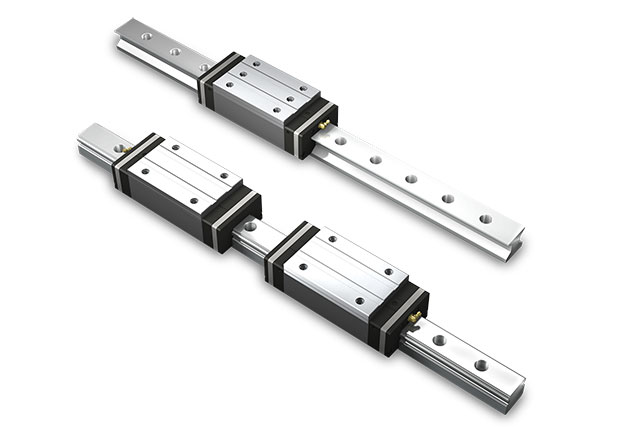 A linear rail system is designed to support the movement and load of a piece of equipment in a linear way, which can be vertical or horizontal. Linear rails have many advantages over other systems thanks to their high accuracy and stability. When choosing a linear rail system, you have the ability to customize the components to get the exact specifications necessary for your application.
A linear rail system is designed to support the movement and load of a piece of equipment in a linear way, which can be vertical or horizontal. Linear rails have many advantages over other systems thanks to their high accuracy and stability. When choosing a linear rail system, you have the ability to customize the components to get the exact specifications necessary for your application.
Definition of Linear Rails
A linear rail is a component of a linear system. Most linear rails are flat surfaces on which a rolling or gliding element will move. Linear guide rails are typically made from high-strength, hardened, and galvanized steel to resist corrosion. The metal is manufactured using a cold drawing process, then shaped and profiled before completion with the roller runner. A linear rail’s main components are the carriage, bearings, and guide rails. The system can also include drive units, sensors, controllers, lubrication systems, and additional components, depending on the application. Several varieties of linear rails, including profiled and round rails, are used for certain applications.
Purpose and Significance
The primary role of linear rails is to facilitate smooth and precise linear motion within various industrial and commercial applications. Linear rails enable controlled movement of objects along a straight path. The linear rail system will sustain and support the equipment, allowing the movement of the object through a production or packaging process.
Types of Linear Rails
There are several types of linear rails, but the two most popular are profiled linear rails and round rails.
Profiled Linear Rails
Profiled linear rails are sometimes referred to as square rails. They utilize an inner and outer rail, which makes up the carriage. Profiled linear rails are used in many different applications. They are well-suited for high-load applications that require high accuracy and stiffness, as the load will be supported throughout the length of the rail. Profile rails do require precise installation.
Round Rails
Round rails are often considered a lower-cost option when the precision and support needs are not as important. Round rails are sometimes referred to as ball bushings and have a shaft rail assembly with open bearings.
Application of Linear Rails
Linear rails have numerous applications in many different industries. As they are customizable, they can be adapted to enhance a variety of industrial tasks.
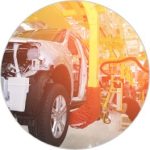 Industrial Automation
Industrial Automation
Industrial automation is a place where one would expect to see linear rail systems. Linear rails are employed in material handling systems, conveying materials efficiently and accurately within manufacturing facilities. Many automated assembly lines utilize linear rails for precise movement and positioning of components. Linear rails are also integrated into packaging machinery to ensure precise product filling, sealing, and labeling. The efficiency and reliability of linear rail-based packaging systems have been proven many times. In addition, linear rails facilitate the movement of sensors and cameras in quality control and inspection systems. Linear rails enhance the accuracy of inspection processes in manufacturing.
 Robotics
Robotics
As the robotics industry advances, linear rail systems will play a large role in collaborative robots, surgical robots, and automated guided vehicles. In collaborative robots (cobots) linear rails allow them to perform delicate tasks with high precision. Cobots using a linear rail system are precise and successful in tasks requiring human-like dexterity and accuracy. Linear rails are also utilized in robotic surgical systems, providing stability and accuracy during surgeries. Surgical robotics require a very high degree of precision, and linear rail systems can provide that. Linear rails enable Automated Guided Vehicles (AGVs) to navigate autonomously in industrial environments, transporting goods and materials. AGVs can optimize logistics and material flow within large manufacturing facilities using linear rail technology.
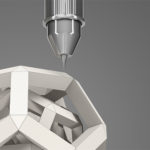 3D Printing
3D Printing
3D printers rely on linear rail systems to function. During the printing process with large-scale 3D printers, linear rails ensure precision and stability. For architectural prototypes and industrial designs requiring 3D printing, large-scale 3D printers using linear rail systems are used for their accuracy and precision. Linear rails allow layer-by-layer deposition of materials and are able to function at the high speeds necessary for this style of 3D printing. Automotive and aerospace industries will use high-speed 3D printing for prototyping and production and rely on the accuracy and precision that a linear rail system can provide. When personalized and customized products are required in electronics, 3D printers using linear rail systems provide the prototyping.
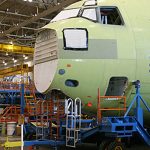 Aerospace Manufacturing and Tooling
Aerospace Manufacturing and Tooling
Aerospace manufacturing and tooling require a high degree of precision and accuracy, making linear rail systems a perfect fit. Linear rails are integral in precisely assembling aerospace components, ensuring tight tolerances and structural integrity in aircraft parts that have no room for error. The innovative and advanced tooling solutions enabled by linear rails enhance the manufacturing of intricate aerospace parts such as turbine blades and airframe components.
 Oil and Gas Sector
Oil and Gas Sector
The oil and gas sector has unique challenges and linear rail systems are designed to work within those challenges. Linear rail systems play a big role in automated drilling systems, as they maintain stability and accuracy during drilling operations, especially in offshore drilling rigs. Pipeline inspection and maintenance is crucial in the oil and gas industry. Using linear rails in the robotic systems used for pipeline inspection and maintenance is critical, as they ensure precise movement and control through the most challenging terrains. Safety is always a concern in the oil and gas sector, and linear rail technology contributes to implementing advanced safety protocols, helping to prevent accidents and ensuring the safety of all workers in the industry.
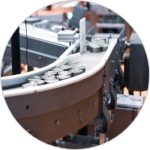 Packaging Industry
Packaging Industry
Packaging processes can be enhanced with linear rail systems. In conveyor systems, the integration of linear rails enables smooth and precise movement of packages along the production line, resulting in higher throughput and reduced errors. In robotic packaging applications, linear rail systems can also enhance the system, enabling robots to handle packages with accuracy, speed, and agility, improving overall packaging efficiency. Linear rail-equipped machines optimize packaging processes, reducing waste and contributing to sustainable packaging practices in line with environmental regulations and market demands.
 Semiconductor Manufacturing Equipment
Semiconductor Manufacturing Equipment
Linear rail systems provide a high degree of precision in semiconductor manufacturing, as they are cleanroom compatible, can work with advanced positioning systems, and aid in quality control processes, contributing to higher yield rates by reducing defects in semiconductor components, thus maximizing production efficiency and profitability. Specialized linear rail technology can be designed for semiconductor cleanrooms, helping to prevent contamination and ensure the cleanliness required for microchip manufacturing with their specialized design. In advanced positioning systems, linear rail systems can provide precise wafer handling and intricate circuit patterning. Linear rail systems are the ideal choice for all semiconductor manufacturing equipment.
Advantages of Using Linear Rails Over Other Types
There are many options for linear motion systems, but linear rails have some significant advantages, making them a strong choice.
Precision and Accuracy
Linear rail systems offer high precision and movement accuracy, which is crucial in most applications and industries. Consistent motion with minimal backlash allows for a high degree of precision not present in many other options.
Smooth and Quiet Operation
Quiet operation is critical in many industries, but particularly in medical equipment. Smooth and quiet motion is essential to enhance the overall user experience. Other systems, such as lead screw systems or rack and pinion, may produce vibrations and noise during operation. Pneumatic and hydraulic systems can also be very noisy. When smooth and quiet operation is a concern, linear rail systems are the obvious choice.
High Load Capacity
The robust design of linear rails allows them to handle heavy loads with stability and smooth motion. Linear rail systems have an extremely high load-bearing capacity when compared with other systems, particularly in industrial applications. During the customization process of linear rail systems, the load-bearing needs can be factored into the system, using materials and assembly that has the necessary load capacity to handle the load while not compromising on motion, stability, or friction.
Durability and Longevity
Linear rails are often made from high-quality materials such as hardened steel or aluminum alloys, making them extremely durable and long-lasting. Linear rail systems with proper maintenance have a greater extended lifespan when compared to other options. While wear and tear are seen in nearly every linear motion system, the use of linear rails notably decreases the wear and tear, making them the more durable choice for long-term use.
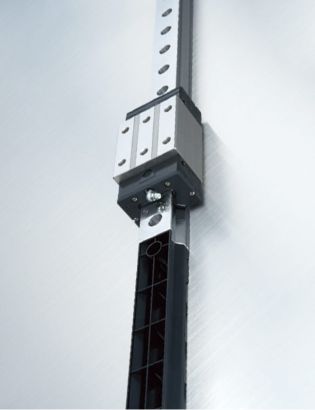 Low Friction and Energy Efficiency
Low Friction and Energy Efficiency
One of the greatest benefits of using a linear rail system is the low friction. Low friction has many advantages, such as reducing energy consumption and improving efficiency. Any friction in the linear movement will force the system to work harder. Other systems, such as those using lead screws, have increased friction, which results in an increase in energy consumption. The savings in energy achieved through the smooth movement of linear rail systems makes them a superior choice instead of an alternative option.
Maintenance and Reliability
Every industrial component will require some degree of maintenance, but linear rail systems have the advantage of minimal maintenance requirements. This leads to increased reliability and reduced downtime, which is crucial in many industries. Other options are systems that might require frequent lubrication or adjustments, along with consistent monitoring for potential issues. Linear rail systems are optimal for continuous operations, as many self-lubricating features can reduce maintenance needs even further.
Versatility and Flexibility
The customization of linear rail systems is one of the greatest benefits when compared to other options. Linear rail systems can be easily integrated into various applications and customized to fit specific requirements for nearly every industry. When compared with rigid systems like rack and pinion, linear rail systems have a distinct advantage in adaptability for diverse industrial and commercial uses.
Enhanced Speed and Acceleration
The enhanced speed and acceleration capabilities of linear rail systems is not just hype. Linear rail systems facilitate high-speed movements and rapid accelerations, which is crucial for applications requiring quick and precise motions. Because of their ability to sustain loads, linear rail systems can handle travel speeds of up to 5m/s, which is critical in many applications. Linear rail systems have significant advantages in dynamic tasks.
Cost-Effectiveness
Integrating any linear motion system requires an investment, both for the implementation and maintenance and upkeep of that system. When comparing systems, it is important to look beyond the initial investment and into the long-term cost savings. The initial investment in linear rails will lead to cost savings over time due to the durability and low maintenance requirements of linear rail systems. When considering the total cost of ownership, the economic benefits of choosing linear rails for long-term projects are far superior to other options.
Safety and User Experience
High-quality linear rail systems will have built-in protections against overloads and accidents as part of the standard safety features to ensure safe use. If the linear rail system is not used as intended, safety can become a factor; however, with proper use, linear rail systems are safe in all applications. Safety is critical in industrial and commercial environments. Using linear rail systems contributes to a secure working environment, ensuring smooth and controlled motion. Because linear rails are manufactured to much tighter tolerances than other systems, they are less likely to fail during operation.
Common Problems and Solutions with Using Linear Rails
Linear rail systems are among the most effective for achieving smooth linear motion in various applications. However, as with all parts, several issues can develop over time. One of the benefits of linear rail systems is that the common problems have solutions that are easy to implement.
Problem: Misalignment Issues
Solution: Regular Alignment Checks
Proper alignment is essential for smooth linear motion. To avoid alignment issues, regularly check and adjust the alignment of linear rails and guides to ensure they are parallel with each other and perpendicular to the motion direction. Use precision tools such as dial indicators and laser alignment devices for accurate adjustments. During the system implementation, alignment checks and adjustments will be set to ensure that maintenance can be done easily.
Problem: Contamination and Wear
Solution: Proper Lubrication and Sealing
The environment in which your linear guide system operates can impact the performance of the linear rail. Dust, dirt, and other contaminants, when in the rail systems, can cause resistance in the linear motion. After implementing a linear rail system, consult with NSK to apply suitable lubricants to reduce friction and wear between the rail and the bearing elements. When designing your system, consider the environment and make the correct choices at the time of installation to keep the system free from environmental contaminants. To best keep contaminants out, install effective sealing mechanisms, such as wipers and bellows to prevent dust, debris, and moisture from contaminating the rail system.
Problem: Uneven Load Distribution
Solution: Load-Balancing Techniques
Linear rail systems can handle large loads, but uneven load distribution can cause problems. Uneven load distribution can add stress and cause damage to your linear rail systems over time. When the load is unbalanced, more stress is placed and can cause warping and impact the smoothness of the linear motion. To address this issue, distribute the load evenly across the entire length of the rail by using multiple bearing blocks or guides. In addition, when customizing linear rail systems, opt for rail designs with integrated load-sharing features to ensure uniform stress distribution.
Problem: Excessive Noise and Vibration
Solution: Damping and Isolation
The need to run machine tools at high rates of speed can lead to vibration and excessive noise from the linear rail system. As linear rail systems continue to advance in higher speeds and greater throughput, the low friction of these systems can offer poor damping because of the metal-to-metal contact and the vibrations that come with higher speeds. When noise and vibration are a concern, choose linear rail systems with built-in damping features to minimize resonance and enhance stability. Adaptive elements built into the linear guides can often improve damping. When developing a customized linear rail system, expressing concerns about excessive noise and vibration can be addressed as the system is designed, making the problem much easier to solve than after implementation.
Problem: Inadequate Lubrication
Solution: Scheduled Lubrication Maintenance
Although linear rail systems are low maintenance when compared with other guide systems, they do require lubrication maintenance on a regular schedule to ensure they will continue to function at optimal performance and to avoid any issues that can arise from inadequate lubrication, such as premature wear, bearing failure, or load balancing issues. After implementing a linear rail system, establish a regular lubrication schedule based on NSK’s recommendations for your linear rail system and application. Use appropriate lubricants recommended during the system implementation and follow proper lubrication techniques to ensure smooth operation and prevent premature wear.
Problem: Bearing Failure
Solution: High-quality bearings and Maintenance
When bearings fail, it is typically because the bearings used were not optimal for the specific application. Choosing high-quality bearings will make a big difference in the success of your linear rail system. Customization will solve many of these issues before they have the opportunity to fail. Before installing your linear rail system, consider your requirements and invest in high-quality bearings that match the application’s specific load and speed requirements. In addition, maintenance is important. You should regularly inspect bearings for signs of wear, corrosion, or misalignment. Replace all bearings promptly if any issues are detected. Preventive maintenance can take care of most problems caused by bearing failure.
Problem: Lack of Rigidity
Solution: Reinforcement and Stiffening
Rigidity in the linear rail is important for the accuracy, stability, and longevity of the linear rail system. A lack of rigidity is often due to lack of support in the structure. To solve this issue, reinforce the mounting structure and frame to enhance overall rigidity, especially in applications with high acceleration or deceleration forces that will put strain on the system. Profile rails are stiffer and more rigid than other options. In addition, consider using linear rail systems with integrated stiffening elements or profiles for stability.
Problem: Insufficient Speed or Acceleration
Solution: Higher Precision and Lightweight Materials
Linear rail systems can be customized to meet the needs of your application, and some applications require higher rates of speed and acceleration in their linear rail system. If higher speeds or acceleration is necessary for your application, opt for linear rail systems for high-speed applications featuring precision-ground surfaces and lightweight components to achieve the optimal results. Materials can make a difference in speed, acceleration, and precision. Customizing your linear rail system with the right materials will give you the exact performance you need. Use linear rails from materials that offer low inertia and support rapid acceleration, such as carbon fiber instead of aluminum.
Problem: Compatibility Issues
Solution: Thorough System Integration Testing
Compatibility issues can be a real concern when integrating any new system, and are typically the result of attempting to integrate a linear rail system without doing the research and testing ahead of time to find out what will work with existing components. The best strategy is to conduct comprehensive compatibility tests before finalizing the linear rail system. As linear rail systems are fully customizable to work with various applications, testing ensures compatibility with the other components in your applications such as motors, controllers, and drive systems. When you are integrating a linear rail system, collaborate closely with manufacturers and suppliers to address any integration challenges to achieve seamless compatibility.
Elevate Your Operations with Customized NSK Linear Rail Systems
Linear rail systems are widely used across a variety of industries and in many different applications. Designed to support movement in a linear direction, linear rail systems are a relatively simple piece of mechanical equipment designed to do a job well. Using a linear rail system will allow whatever needs to move to do so smoothly, precisely, and safely. Because of the wide variety of sizes, preloads, materials, and accuracy classes, linear rail systems are suitable for nearly every application and can be customized to fit the exact needs of many different industries.
Working with NSK to develop linear rail systems for your facility will help you achieve smooth and accurate motion benefits for all your needs. NSK’s high quality systems can be customized, are reliable in performance and durability, and are competitively priced. NSK is considered one of the top companies for linear rail systems, and we can guide you in determining a customized system to meet your needs.
